Continued from A Sniper Rifle is Born in Russia – Part 1.

When I was going to visit ORSIS, the media broadcast a program about an old Russian weapons factory manufacturing elite hunting rifles. It showed a number of barrels strengthened in clamps and sullen young men, who looked more like vocational students than experienced workers. With those images in mind, I left home and headed for ORSIS.
Frankly, I was afraid of seeing a private workshop. Though the advertising was good and their rifles looked impressive, I wondered what this “factory” was really like – a couple of new machines and several enthusiasts?
However, ORSIS surprised me within the first couple of steps. Walking in on a rainy autumn day, I found myself inside a light-filled mix of glass, stone and fine-wood interior with only rifles on display in showcases to give away what it really was.. There were many different rifles, including elegant and lightweight hunting rifles, as well as high-tech sniper rifles which were heavy and clumsy in appearance, but very accurate and precise rifles used for Benchrest shooting. Mounted on a bipod on a mahogany stand, there was the famous T-5000 high-precision sniper rifle, which had literally burst into the Russian world of firing arms.
“Weapons are toys of men!” – You only fully understand the saying when you find yourself in an arsenal or such a shop. You want to hold each model, listen to your inner feeling and imagine that it was your rifle. You are eager to feel soft sliding of a bolt – the perfect dance of mechanics. You want to ask a lot of “why?” and “what for?” questions…
“Interesting that the idea of the factory was born in the midst of the crisis, in 2008,” says Alexei Sorokin, CEO of the Promtechnologies Group, “when you would think you should have curled up and sat quietly, waiting for the end of it. But we believed that the crisis was a temporary situation, and in the spring of 2009 handled all the documents and were allowed to establish the firing arms production. On May 15, 2010, builders started work in an abandoned shop of a Moscow factory; on December 11 we made the first barrel and in early February 2011 – the first rifle.”
The factory itself started right outside of the office, where I was kindly invited by Deputy CEO Alexei Rogozin and Director Alexander Kostin. Behind the wall, in the enormous workshop, just a few steps away from the office leather chairs, there was a powerful machine making a barrel. Special holders contained a dozen barrels in different stages of production. Right behind it there was the pride of the plant – an ultra-accurate rifling machine forming the ideal inner surface for an exceptional precision at a maximum shooting range. Like a true gunsmith, in almost complete silence and with majestic smoothness, the machine slid in and out of the dark barrel. The tiny stream of golden oil flowed on the gun stick and it seemed that the machine did not touch the barrel at all when sliding back and forth, but the microscopic steel powder at the bottom of the pan proved that the machine was tirelessly and methodically forming grooves deep inside the barrel. On its moving platform, a coin was standing on the edge – a demonstration of the accuracy and smoothness of the machine.
Mr. Kostin and Rogozin, sporting the latest fashion, did not contrast with the “working” space of the factory, which was as clean as the best hospital. Freshly painted walls and floors lined with the steel profile painted ivory. Workers and engineers were wearing stylish uniforms stamped with Promtechnologies on the back. And even the Starrett marble slabs of the worktops emphasized the status of the plant. Kostin and Rogozin’s suits and white shirts were just the very style of the factory.
“I became a fan of firearms when I was a schoolboy ,” says Alexei Sorokin, CEO of the Promtechnologies Group. “The retired Lieutenant Colonel G. G. Kuznetsov taught military disciplines in my school, in Vladivostok. My passion for firearms began with my teacher’s small arsenal – some training Kalashnikov assault rifles, air and small-caliber rifles. However, at first I liked shooting more. I was drafted in Khabarovsk and joined the sports platoon of the 1st Air Army, where I became master of sports. Then I entered the Coaching Department of the Institute of Physical Education and got my degree as a shooting coach. Unfortunately, those were the bad nineties, when the mass sport was dying and to feed the family on the coach’s salary was impossible. Only criminals paid well for training, but I did not wish to help and teach them. So I had to forget about my degree and do something completely different. I started my own business. I dealt with firearms just one more time in those years – when I bought a sporting rifle with my own money for a promising young athlete, A. Blinov. A few years later the very Alexander Blinov got a silver medal at the Athens Olympics.“
“In 2007 I was offered an opportunity to lead a small arms production operation in Zelenograd, where Sphinx pistols, clones of the CZ’s Shadows, were manufactured. So, I went back to my passion, firearms. Soon after my resignation, the idea of ORSIS Company was born. As a commercial project, it was aimed at making profit by establishing elite firearms products in a niche where there has been no domestic production at all.”
Today the ORSIS Factory is a unique weapons enterprise. There is no other like it either in Russia or elsewhere in the world. And if nowadays the Russian government likes talking about innovations, ORSIS is the best example of such innovations. Several enthusiasts-founders joined forces and capital to create a completely new, extremely modern manufacturing and production operation that would utilize the latest cutting-edge technologies. And, they did it! The accuracy of ORSIS rifles significantly outperforms most common sniper rifles.
Ballistics, as a science, makes wide use of the term minute of angle (MOA), which is mathematically equivalent to minute of arc. This parameter refers to the precision of shooting in the absence of wind, and, as a rule, is measured on the basis of 3-5 shots. A rifle with a ballistic coefficient equal to 1.0 has a precision of about 2.9 cm when shot at a distance of 100 meters (or approximately 1.047 inch at 100 yards). A firearm with a MOA less than 1.0 is said to be precise, or of sniper accuracy. Promtechnologies guarantees that all ORSIS rifles display a precision of no more than 0.5 MOA and some models have even higher precision. Up until recently, only the best foreign manufacturers have achieved such performance.
The facilities at the Promtechnologies factory feature a complete cycle of rifle production, ranging from the manufacturing of barrels, actions, trigger mechanisms and stocks to the assembly and inspection of finished products. Barrels are made from stainless and chromium-molybdenum alloy steel. All processes, including deep drilling, bore reaming and chambering, are performed on the unique equipment, both foreign- and locally-made, developed by the company’s engineering design bureau in Moscow using imported components with the participation of foreign experts. The precision workmanship offered by these tools makes it possible to bore a virtually perfect inner-barrel surface, thus ensuring superb quality. Equipment for making such high-precision barrels are nowhere else to be found in Europe.
Unfortunately, unique ORSIS products are much more in demand abroad and by private enthusiasts of high-precision shooting, hunters, sportsmen, but not by the Russian Ministry of Defense. Our officials have been equipping the army snipers with foreign rifles for over three years now, saying the domestic industry is not able to create high-quality sniper rifles.
At first, thanks to an adviser to the Minister Serdyukov, we bought the British L-96 rifles. Then, we chose the Austrian SSG 04 Steyr-Mannlicher. And most recently, the Defense Ministry announced a competition for 550 .338 Lapua Magnum rifles. However, under the stated parameters – 6 rounds, the length of 1,272 mm (sharp), the barrel of 690 mm (sharp), and the weight of 6 kg – only one fits the description – the SSG 08 Steyr Mannlicher rifle. In fact, it’s not a competition, but a cynical push for a specific model. At the same time, nobody even considered that the single-option “competition” actually deprives the buyer (Russian Ministry of Defense) of the opportunity to negotiate lower prices. There is no alternative; therefore, there is a monopoly and an opportunity to state the price. Under the contract, the rifle costs over 8,000 euros. However, the T-5000 ORSIS rifle is twice as cheap. But the Austrian rifle must have good “pushers” within the Ministry of Defense. At least one of the documents posted on a small arms forum clearly states that the price of a rifle is based on the commercial offers of the Arsenal and Kolchuga private shops…
But the ORSIS does not lose hope because of the indifference of our military officials. The factory has many orders, and their numbers are steadily increasing. The factory does not work for warehousing, but manufactures elite rifles for many customers, including Russian security agencies.
“To run such a production is a complex science,” says Alexey Sorokin. “I always have to learn. And most of this knowledge you can’t get at a university, but you get it only from practical experiences. For example, when we just started the production line, we were so happy and eager to work that we took on any all orders. As a result, we overextended ourselves and faced a serious problem of keeping the deadlines. We had to work hard. We did it, but now we are much more cautious. Today we can adequately estimate our production facilities and see the difference between being profitably busy and overloaded..”
“We’ve started dealing with the world’s largest small arms companies. Though they are mainly observing and evaluating us.”
“Our existing facilities are capable of producing up to five thousand rifles a year. But the global market may adopt much more. And even now we are thinking of expanding the production. Learning about our high-tech equipment, we’ve been approached by several representatives of medical companies who are interested in parallel production opportunities with our factory.”
But ORSIS’s plans are far beyond the elite firing arms. Its designers are developing advanced semi-automatic rifles and pistols. However, their production will be the next stage of the Promtechnologies Group’s development when it establishes a new factory this year.
Nowadays ORSIS has a great deal of re-barreling orders for existing rifles, replacing worn-out barrels with a new ones. Interestingly enough, such orders include many Mosin rifles, as the rifle is a true rarity among the collectors. The oldest Mosin rifle re-barreled by the factory was manufactured in 1914! And there is a kind of continuity and recognition of the ORSIS quality–the Mosin rifle is turned into the Mosin-ORSIS one.
The factory also re-barrels foreign firing arms, including the army rifles bought abroad by security forces. Without ORSIS, the owners would have paid at least half the price of a new rifle for re-barreling. And the Defense Ministry may soon face these problems… Don’t forget that most manufacturers of sniper rifles, including those used in law-enforcement agencies of Russia, don’t include repair and re-barreling under their conditions of services. Therefore, until recently the rifle’s service life has been limited by the barrel’s lifespan. Also, according to several reports, foreign manufacturers are still carrying out a country-based product selection. That is, the quality of the barrels and receivers are radically different for the rifles that go to Russia from those that go to the national security and other foreign agencies. Of course, not in favor of Russia.
Any rifle has its service life, limited by lifespan of the barrel, receiver and trigger. And out of all, the barrel wears out the fastest. Most manufacturers like mixing and changing the two definitions: the barrel’s accuracy lifespan –when the barrel loses the high accuracy, and the lifespan of the barrel –when it is no longer possible to make a safe shot. For sniper shooting, the first definition is the determining one.. But manufacturers usually indicate the latter, though the barrel’s accuracy may be lost halfway through the barrel’s lifespan.
So far, not one ORSIS rifle has lost its accuracy, though many of them have shot much more than others of their caliber…
My factory tour came to an end. And the rifles, like models after a presentation, went behind the scenes–inside their glass showcases. After a glimpse of the future of the Russian firing arms, it was time to go back to the day-to-day reality.
In the endless Moscow traffic jam, I could not stop thinking of the factory and of what I had just seen. What is the future of ORSIS? Will the factory take off and take its place in the vast archipelago of the Russian industry? Will its technology be in demand? Only the time will tell. And I want to believe that it’s on ORSIS’ side.


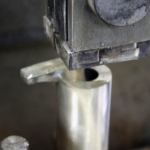
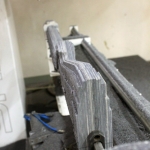
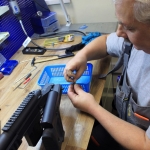
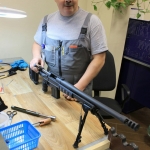
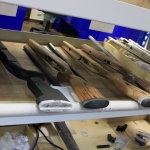
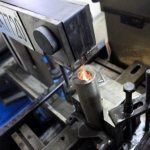
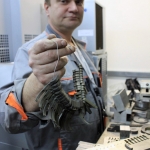
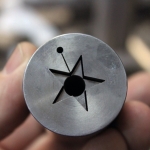
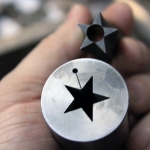
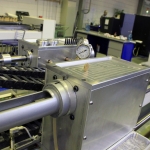
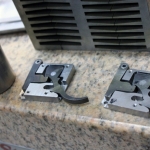
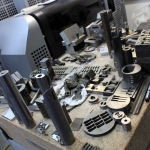
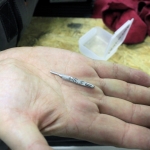
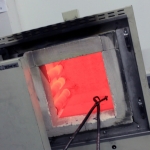
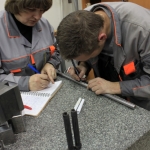
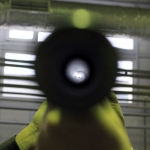
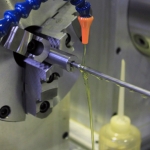
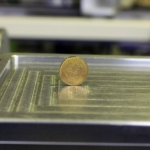
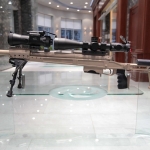
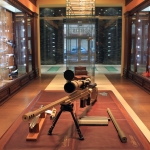
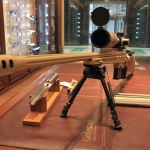
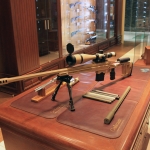
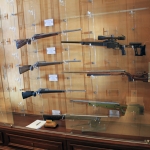
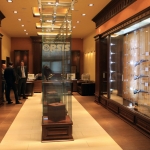
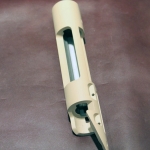











[…] ORSIS High-Precision Hunting, Sport and Tactical Rifles … – The small arms factory, owned by the Promtechnologies Group of Russia, manufactures ultra high-precision hunting, sport and tactical rifles. […]
[…] interesting rifles were on display at this Sniper Match, including Russian designed-and-built Orsis T-5000 rifles. A T-5000 chambered in 7mm RSAUM won the Armourers’ Day Match. This alloy-chassis […]
Comments are closed.